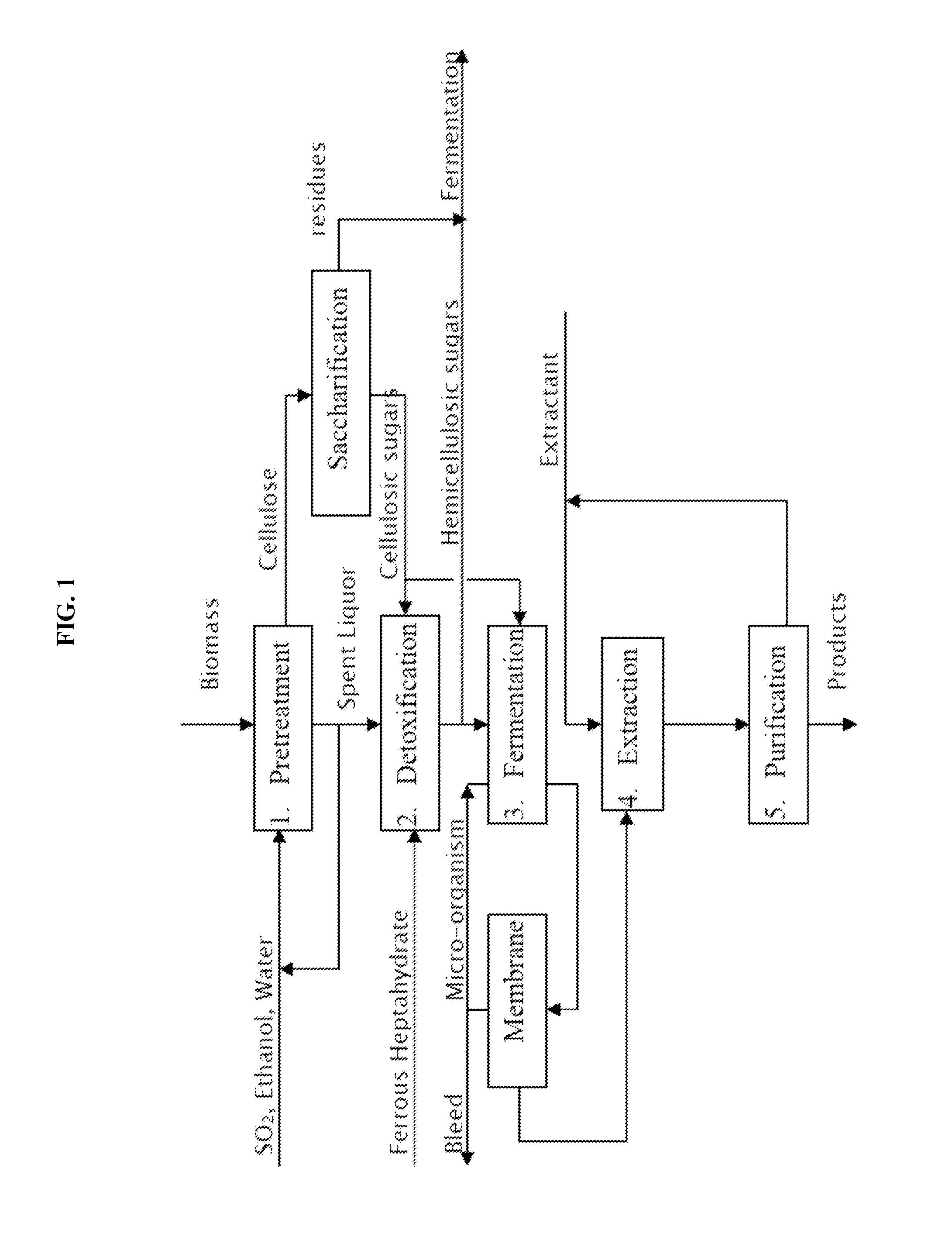Processes for fermentation of lignocellulosic glucose to aliphatic alcohols or acids
a technology of lignocellulosic glucose and aliphatic alcohol, which is applied in the field of processes for converting lignocellulosic glucose to aliphatic alcohol or acid, can solve the problems of affecting the conversion efficiency of pentose, affecting the efficiency of heat recovery, so as to achieve the effect of improving heat recovery
- Summary
- Abstract
- Description
- Claims
- Application Information
AI Technical Summary
Benefits of technology
Problems solved by technology
Method used
Image
Examples
example 1
[0149]Cooking of sugarcane straw was conducted with lower ethanol concentration (35 wt %) in mini-reactors of a multi-digester oil bath, compared with previous cooking at higher ethanol concentration (50 wt %). Both cooks were performed at 155° C. for 58 minutes with 12% SO2 at L / W ratio of 4 L / Kg.
[0150]Results are summarized in Table 1. The fiber yield as a result of cooking with 35% ethanol is higher than that with 50% ethanol, because more lignin dissolved at higher ethanol content. This is inferred from the lower Kappa number of the cellulose fibers produced at 50% ethanol cooking. Lignin-free yields of fiber produced with 35% and 50% ethanol are 38% and 35%, respectively.
TABLE 1Composition of sugarcane straw fibers produced with different ethanol concentrations% on od fiberH / (C + H), %IDCellHemiLigninAcGUAGAshHemicellulose35% EtOH78.0 ± 0.83.9 ± 0.24.8 ± 0.10.01.5 ± 0.38.5 ± 0.44.750% EtOH82.3 ± 1.34.5 ± 0.13.5 ± 0.30.01.6 ± 0.38.4 ± 0.15.2C: Cellulose;H: Hemicellulose;AcG: Ace...
example 2
[0151]Cooking of sugarcane straws was conducted in the mini-reactors of a multi digester oil bath. The pulp fibers were produced with subsequent washing and fiber preparation. Design of experiments was followed according to Table 2. The cooking conditions with low ethanol resulted cellulose fibers with low hemicelluloses but relatively high Kappa number. The ethanol:water ratios of 1:4 and 1:3 were able to produce fibers with less than 2% hemicellulosic sugars from sugarcane straw. Also, depending on ethanol concentration of cooking liquor, Kappa number of pulp increases while hemicellulose content does not change much during longer cooking time. Material loss was observed during longer cooking periods.
TABLE 2Cooking conditions of sugarcane straw and the resultsCooking conditionsResultsSugar of fiberRunTemp.TimeSO2EtOH:H2OL / SYield,KappaCell.Hemi.#(° C.)(min)(%)(w:w)(w / w)(%)#(%)(%)1116058181:1634.312.684.14.11716068181:1634.711.787.42.81315558121:1438.514.384.65.01515598121:1435.416....
PUM
| Property | Measurement | Unit |
|---|---|---|
| Temperature | aaaaa | aaaaa |
| Temperature | aaaaa | aaaaa |
| Fraction | aaaaa | aaaaa |
Abstract
Description
Claims
Application Information
 Login to View More
Login to View More - R&D
- Intellectual Property
- Life Sciences
- Materials
- Tech Scout
- Unparalleled Data Quality
- Higher Quality Content
- 60% Fewer Hallucinations
Browse by: Latest US Patents, China's latest patents, Technical Efficacy Thesaurus, Application Domain, Technology Topic, Popular Technical Reports.
© 2025 PatSnap. All rights reserved.Legal|Privacy policy|Modern Slavery Act Transparency Statement|Sitemap|About US| Contact US: help@patsnap.com

